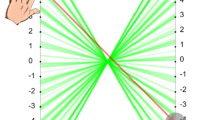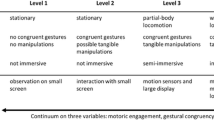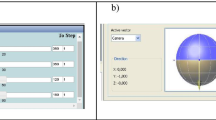Abstract
This chapter focuses on the KOM-framework’s aids and tools competency and investigates its application in the digital era for mathematical learning. The aids and tools competency may be viewed as distinguishing between more classical material or physical tools (e.g., centicubes, rod systems, abacuses, rulers, compasses, protractors, specially lined paper, cardboard for folding or cutting) and digital tools (e.g., calculators, computers and mathematical software, such as computer algebra systems and dynamic geometry environments). Although this distinction seems straightforward, new software somewhat blurs the picture, since now several virtual manipulatives serve the purpose of illustrating and explaining physical manipulatives. The chapter suggests a potential networking of the aids and tools competency with, on the one hand, the theoretical constructs of instrumental genesis and on the other hand, embodied cognition as manifested through the newly suggested idea of embodied instrumentation. A series of examples is provided to illustrate the potential of applying these theoretical frameworks in connection with each other.
Access this chapter
Tax calculation will be finalised at checkout
Purchases are for personal use only
Similar content being viewed by others
Notes
- 1.
- 2.
This example and the subsequent analysis in terms of both the aids and tools competency and the instrumental approach was initially presented at the 2018 MEDA conference (Jankvist et al., 2018).
- 3.
- 4.
See: https://mathigon.org/ and https://youtu.be/vwyIZsi0b98 by following the link: https://mathigon.org/polypad.
- 5.
References
Alberto, R., Bakker, A., Walker-van Aalst, O., Boon, P., & Drijvers, P. (2019). Networking theories in design research: An embodied instrumentation case study in trigonometry. In U. T. Jankvist, M. Van den Heuvel-Panhuizen, & M. Veldhuis (Eds.), Proceedings of the eleventh congress of the European Society for Research in Mathematics Education (pp. 3088–3095). Freudenthal Group & Freudenthal Institute, Utrecht University and ERME.
Artigue, M. (2002). Learning mathematics in a CAS environment: The genesis of a reflection about instrumentation and the dialectics between technical and conceptual work. International Journal of Computers for Mathematical Learning, 7(3), 245–274.
Artigue, M. (2010). The future of teaching and learning mathematics with digital technologies. In C. Hoyles, & J.-B. Lagrange (Eds.), Mathematics education and technology—Rethinking the terrain. The 17th ICMI study (pp. 463–475). Springer. https://doi.org/10.1007/978-1-4419-0146-0_23
Arzarello, F., Paola, D., Robutti, O., & Sabena, C. (2009). Gestures as semiotic resources in the mathematics classroom. Educational Studies in Mathematics, 70(2), 97–109. https://doi.org/10.1007/s10649-008-9163-z
Bakos, S., & Sinclair, S. (2019). Exploring the semiotic potential of TouchTimes with primary teachers. In J. Novotná, & H. Moraová (Eds.), Proceedings of international symposium of elementary mathematics teaching: Opportunities in learning and teaching elementary mathematics (pp. 53–62). Charles University, Faculty of Education.
Barad, K. (2007). Meeting the universe halfway: Quantum physics and the entanglement of matter and meaning. Duke University Press. https://doi.org/10.2307/j.ctv12101zq
Ball, D. (1992). Magical hopes: Manipulatives and the reform of math education. American Educator, 16(2), 14–18, 46–47.
Bartolini, M. G., & Martignone, F. (2014). Manipulatives in mathematics education. In S. Lerman (Ed.), Encyclopedia of mathematics education. Springer. https://doi.org/10.1007/978-94-007-4978-8_93
Bikner-Ahsbahs, A., & Prediger, S. (2014). Networking of theories as a research practice in mathematics education. Springer. https://doi.org/10.1007/978-3-319-05389-9
Châtelet, G. (2000). Figuring space philosophy, mathematics, and physics. Kluwer Academic Publishers.
Clements, D. H. (2000). ‘Concrete’ manipulatives, concrete ideas. Contemporary Issues in Early Childhood, 1(1), 45–60. https://doi.org/10.2304/ciec.2000.1.1.7
de Freitas, E., & Sinclair, N. (2014). Mathematics and the body: Material entanglements in the classroom. Cambridge University Press. https://doi.org/10.1017/CBO9781139600378
Drijvers, P. (2019). Embodied instrumentation: Combining different views on using digital technology in mathematics education. In U. T. Jankvist, M. Van den Heuvel-Panhuizen, & M. Veldhuis (Eds.), Proceedings of the eleventh congress of the European Society for Research in Mathematics Education (pp. 8–28). Freudenthal Group & Freudenthal Institute, Utrecht University and ERME.
Drijvers, P., Godino, J. D., Font, V., & Trouche, L. (2013). One episode, two lenses: A reflective analysis of student learning with computer algebra from instrumental and onto-semiotic perspectives. Educational Studies in Mathematics, 82(1), 23–49. https://doi.org/10.1007/s10649-012-9416-8
Geraniou, E., & Jankvist, U. T. (2019). Towards a definition of “mathematical digital competency.” Educational Studies in Mathematics, 102(1), 29–45. https://doi.org/10.1007/s10649-019-09893-8
Guin, D., & Trouche, L. (2002). Mastering by the teacher of the instrumental genesis in CAS environments: Necessity of instrumental orchestration. Zentralblatt Für Didaktik Der Mathematik, 34(5), 204–211. https://doi.org/10.1007/BF02655823
Hart, K. (1993). Confidence in success. In I. Hirabayashi, N. Nohda, K. Shigematsu, & F.-L. Lin (Eds.), Proceedings of psychology of mathematics education, PMEXVII (Vol. 1, pp. 17–31). University of Tsukuba.
Hunt, A. W., Nipper, K. L., & Nash, L. E. (2011). Virtual vs. concrete manipulatives in mathematics teacher education: Is one type more effective than the other? Current Issues in Middle Level Education, 16(2), 1–6.
Jankvist, U. T., Dreyøe, J., Geraniou, E., Weigand, H.-G., & Misfeldt, M. (2021). CAS from an assessment point of view: Challenges and potentials. In A. Clark-Wilson, A. Donevska-Todorova, E. Faggiano, J. Trgalova, & H.-G. Weigand (Eds.), Mathematics education in the digital age: Learning, practice and theory (pp. 99–120). Routledge.
Jankvist, U. T., Geraniou, E., & Misfeldt, M. (2018). The KOM framework’s aids and tools competency in relation to digital technologies—A networking of theories perspective. In H.-G. Weigand, A. Clark-Wilson, A. Donevska-Todorova, E. Faggiano, N. Grønbæk, & J. Trgalova (Eds.), Research proceedings of the fifth ERME topic conference (ETC 5) on mathematics education in the digital age (MEDA) (pp. 123–130). University of Copenhagen and ERME.
Jankvist, U. T., & Misfeldt, M. (2015). CAS-induced difficulties in learning mathematics? For the Learning of Mathematics, 35(1), 15–20.
Jankvist, U. T., Misfeldt, M., & Aguilar, M. S. (2019). Tschirnhaus’ transformation: Mathematical proof, history and CAS. In E. Barbin, U. T. Jankvist, T. H. Kjelsen, B. Smestad, & C. Tzanakis (Eds.), Proceedings of the Eighth European Summer University on History and Epistemology in Mathematics Education ESU 8 (pp. 319–330). Oslo Metropolitan University.
Johansen, M. W., & Misfeldt, M. (2020). Material representations in mathematical research practice. Synthese, 197, 3721–3741. https://doi.org/10.1007/s11229-018-02033-4
Lagrange, J.-B. (2005). Using symbolic calculators to study mathematics. The case of tasks and techniques. In D. Guin, K. Ruthven, & L. Trouche (Eds.), The didactical challenge of symbolic calculators. Turning a computational device into a mathematical instrument (pp. 113–135). Springer.
Lakoff, G., & Núñez, R. (2000). Where mathematics comes from: How the embodied mind brings mathematics into being. Basic Books.
Mariotti, M. A., & Montone, A. (2020). The potential synergy of digital and manipulative artefacts. Digital Experiences in Mathematics Education, 6(2), 109–122. https://doi.org/10.1007/s40751-020-00064-6
Maschietto, M., & Bartolini-Bussi, M. (2009). Working with artefacts: Gestures, drawings and speech in the construction of the mathematical meaning of the visual pyramid. Educational Studies in Mathematics, 70(2), 143–157. https://doi.org/10.1007/s10649-008-9162-0
McNerney, S. (2011). A brief guide to embodied cognition: Why you are not your brain. Scientific American, 4 [Blog post].
Menary, R. (2015). Mathematical cognition—A case of enculturation. In T. Metzinger, & J. M. Windt (Eds.), Open MIND: 25(T) (pp. 1–20). MIND Group. https://doi.org/10.15502/9783958570818
Moyer-Packenham, P. (2016). Revisiting the definition of a virtual manipulative. In P. Moyer-Packenham (Ed.), International perspectives on teaching and learning mathematics with virtual manipulatives (pp. 3–23). Springer. https://doi.org/10.1007/978-3-319-32718-1_1
Moyer-Packenham, P., Bolyard, J., & Spikell, M. (2002). What are virtual manipulatives? Teaching Children Mathematics, 8(6), 372–377.
Niss, M. (2016). Mathematics standards and curricula under the influence of digital affordances: Different notions, meanings, and roles in different parts of the world. In M. Bates & Z. Usiskin (Eds.), Digital curricula in school mathematics (pp. 239–250). Information Age Publishing.
Niss, M., & Højgaard, T. (2011). Competencies and mathematical learning—Ideas and inspiration for the development of mathematics teaching and learning in Denmark (No. 485). IMFUFA, Roskilde University. English translation of part I-VI of Niss and Jensen (2002).
Niss, M., & Højgaard, T. (2019). Mathematical competencies revisited. Educational Studies in Mathematics, 102(1), 9–28. https://doi.org/10.1007/s10649-019-09903-9
Núñez, R. (2009). Numbers and arithmetic: Neither hardwired nor out there. Biological Theory, 4(1), 68–83. https://doi.org/10.1162/biot.2009.4.1.68
Papert, S. (1980). Mindstorms: Children, computers, and powerful ideas. Basic Books.
Roorda, G., Ros, P., Drijvers, P., & Goedhart, M. (2016). Solving rate of change tasks with a graphing calculator: A case study on instrumental genesis. Digital Experiences in Mathematics Education, 2(3), 228–252. https://doi.org/10.1007/s40751-016-0022-8
Shvarts, A., Alberto, R., Bakker, A., Doorman, M., & Drijvers, P. (2021). Embodied instrumentation in learning mathematics as the genesis of a body-artifact functional system. Educational Studies in Mathematics, 107(3), 447–469. https://doi.org/10.1007/s10649-021-10053-0
Sinclair, N., Chorney, S., Güneş, C., & Bakos, S. (2020). Disruptions in meanings: Teachers' experiences of multiplication in TouchTimes. ZDM—Mathematics Education, 52(7), 1471–1482. https://doi.org/10.1007/s11858-020-01163-9
Sinclair, N., & Heyd-Metzuyanim, E. (2014). Learning number with TouchCounts: The role of emotions and the body in mathematical communication. Technology, Knowledge and Learning, 19(1–2), 81–99. https://doi.org/10.1007/s10758-014-9212-x
Soury-Lavergne, S. (2021). Duos of digital and tangible artefacts in didactical situations. Digital Experiences in Mathematics Education, 7(1), 1–21. https://doi.org/10.1007/s40751-021-00086-8
Tran, C., Smith, B., & Buschkuehl, M. (2017). Support of mathematical thinking through embodied cognition: Non-digital and digital approaches. Cognitive Research: Principles and Implications, 2, 16. https://doi.org/10.1186/s41235-017-0053-8
Trouche, L. (2005). Instrumental genesis, individual and social aspects. In D. Guin, K. Ruthven, & L. Trouche (Eds.), The didactical challenge of symbolic calculators. Turning a computational device into a mathematical instrument (pp. 197–230). Springer.
Vergnaud, G. (2009). The theory of conceptual fields. Human Development, 52(2), 83–94. https://doi.org/10.1159/000202727
Acknowledgements
This chapter was partly written in the frame of project 8018-00062B under Independent Research Fund Denmark and project NNF19OC0058651 under Novo Nordisk Foundation.
Author information
Authors and Affiliations
Corresponding author
Editor information
Editors and Affiliations
Rights and permissions
Copyright information
© 2022 The Author(s), under exclusive license to Springer Nature Switzerland AG
About this chapter
Cite this chapter
Misfeldt, M., Jankvist, U.T., Geraniou, E. (2022). An Embodied Cognition View on the KOM-Framework’s Aids and Tools Competency in Relation to Digital Technologies. In: Jankvist, U.T., Geraniou, E. (eds) Mathematical Competencies in the Digital Era. Mathematics Education in the Digital Era, vol 20. Springer, Cham. https://doi.org/10.1007/978-3-031-10141-0_11
Download citation
DOI: https://doi.org/10.1007/978-3-031-10141-0_11
Published:
Publisher Name: Springer, Cham
Print ISBN: 978-3-031-10140-3
Online ISBN: 978-3-031-10141-0
eBook Packages: EducationEducation (R0)




